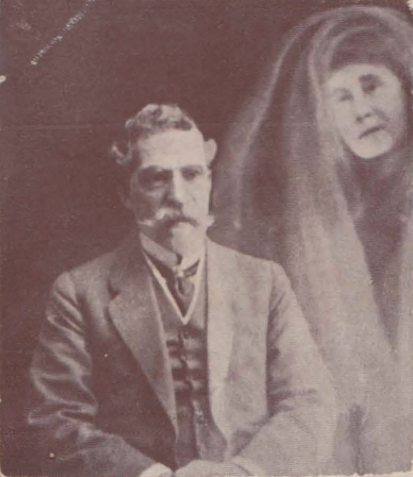Today I hand the transmitter to Benjamin Mitchell, historian of science, library science student, creative writer, bee enthusiast, and casual activist. Beyond his academic work on Nietzche, Ben studies the relationship between various forms of mysticism and science. In this post, Ben opens the door to the world of spirit photography through the experiences of naturalist Alfred Russel Wallace.
The naturalist Alfred Russel Wallace has been getting increasing attention in the past few decades after spending most of the twentieth century in Charles Darwin's shadow.
Wallace was the co-discoverer of evolution by means of natural selection. When he sent a copy of his ideas to Darwin in 1858 while working on the island of Ternate, in Indonesia, the older naturalist despaired that: "I never saw a more striking coincidence. if Wallace had my [manuscript] sketch written out in 1842 he could not have made a better short abstract! Even his terms now stand as heads of my Chapters." Darwin had spent decades thinking about the origin of species, and had come to many of the same views as Wallace. Now, it seemed, he was in danger of losing priority. Instead, he offered Wallace the opportunity to publish a joint paper with him that was read at a meeting of the Linnean Society.
Wallace's relative obscurity in the twentieth century can be attributed to a number of factors. He was far less connected than Darwin, and instead of being the gentlemanly companion of an aristocratic naval officer, he had to fund his own travels by selling his specimens as he went. Darwin considered his main talent to be business, not biology, while Wallace was a socialist. He had also dabbled in mesmerism, was an anti-vaccination activist, and an avowed spiritualist.
Not only did he think it was possible to talk to the dead, he felt that the most scientific demonstration of the existence of life after death could be found through photography.
This may strike you as odd, but you have to understand that Wallace came of age as a naturalist during a period when ideas about expertise and the nature of the self were undergoing dramatic changes. At the start of the nineteenth century philosophers like Immanuel Kant argued that the soul was indivisible and one. By the end of the century it was hard to tell just what kept the psyche together. The modern notion of the profession also developed in the nineteenth century, and brought with it new forms of classicism, and class exclusion.
Wallace was familiar with photography. His brother in law, Thomas Sims, was a professional photographer, and when Wallace's sister died he went out of his way to try and find Thomas another job in his field. Spirit photography was partly so compelling for Wallace because it was a technologically mediated form of observation that was subject to the oversight of both scientific professionals as well as trained amateurs.
Wallace worked with several mediums in his studies of spirit photography. Before we judge him too harshly it is important to keep in mind that Wallace was working with an eighteenth-century sense of the self. It was the unity of the individual that allowed people to make objective observations of the world around them and to bear witness to their own experiences.
Throw the unconscious into this world view, multiple personalities, trances, and other altered states that show the self to be fragmentary and contingent, and you have a potential threat for the very notion of objectivity itself.
The idea of objectivity was not something that Wallace was willing to abandon.
It made far more sense to him that individuals in altered or trance states were actually having their personalities displaced by other, disembodied personalities, and that some egalitarian and objective technology like photography was the most reliable way of demonstrating the proof of this.
I've had several conversations with biologists about Wallace in my time. Most of their assessments of his career could be summarized as: "He was a good scientist once, and then he went crazy." I would argue instead that even if we disagree with his conclusions, he demonstrated a keen sensitivity to some of the fundamental contradictions of his age. One contradiction was that between idealized views of pure objectivity and the increasing evidence that this kind of objectivity was physiologically impossible. Another was the contradiction between the increased knowledge and prestige of experts, and how this authority was used to support the interests and objective of experts themselves. From these negatives he developed an elaborate metaphysical worldview that was as ethically grounded as it was internally consistent.
***
This post entitled “Haunting Negatives: Alfred Russel Wallace, Spirit Photography, and the Unfocused Self” was researched and written by Ben Mitchell. If you would like to read the full academic article it was based on, you can find it here: Capturing the will: Imposture, delusion, and exposure in Alfred Russel Wallace’s defence of spirit photography. You can explore more topics related to esotericism, paranormality, and the culturally weird in the journal Beyond Borderlands. Here you can see another guest post by Toronto editor and photographer James Harbeck.




